Rob Walwyn Captures the Bushfires’ Aftermath on Rare Aerochrome Film
We’re streaming daily on Apple Podcasts, Google Podcasts, Stitcher, Pocket Casts, and Spotify! You can also listen to it right here on The Phoblographer.
“On the 1st of March, 2020, I went for a drive and bushwalk in the Blue Mountains with some friends,” the photographer Rob Walwyn remembers. Two days later, on March 3rd, New South Wales would officially announce that all fires had been contained for the first time in 240 days. When all was said and done, 80% of the Blue Mountains World Heritage Area would burn during the bushfire crisis of 2019-20.
“Driving along the road, you could clearly see the divide between which areas had been hit and which areas had been spared,” Walwyn tells me. “It was clear even without the infrared film the extent of the scarring on the landscape, but it was even more evident when I got the Aerochrome slides back from the lab.” The sight shocked him. Those initial images would evolve into Karrikins, an ongoing project documenting the aftermath of the bushfires on rare infrared film. The series borrows its title from a family of chemical molecules produced by wildfires that can stimulate seed germination and regrowth in plants.
Want to get your work featured? Here’s how to do it!
Even amid the charred swaths of land he saw while walking through the Blue Mountains that day in March, Walwyn found signs of regrowth. While standing at a lookout, he spotted a single goat–a survivor of the fires–on a burnt-out hill. Likely a wild mountain goat, he had discovered some small tufts of grass. By the time the photographer saw him, he was “merrily chomping away” in the distance.
No one knew it then, but later that same month, the first four of twelve rescued koalas would be returned to their homes in Kanangra-Boyd National Park in the Blue Mountains. At long last, the eucalyptus trees could support them once more. We asked Walwyn more about the series.

The Essential Gear of Rob Walwyn
- Pentax 67II
- Pentax 67 75mm f2.8 up to the 400mm f4 ED
- Mamiya 645 AFDII
- Mamiya 45mm f2.8 and 80mm f2.8
- Fujifilm TX-2
- Fujinon 45mm f4
- B+W 040 orange filter
- Kodak Aerochrome
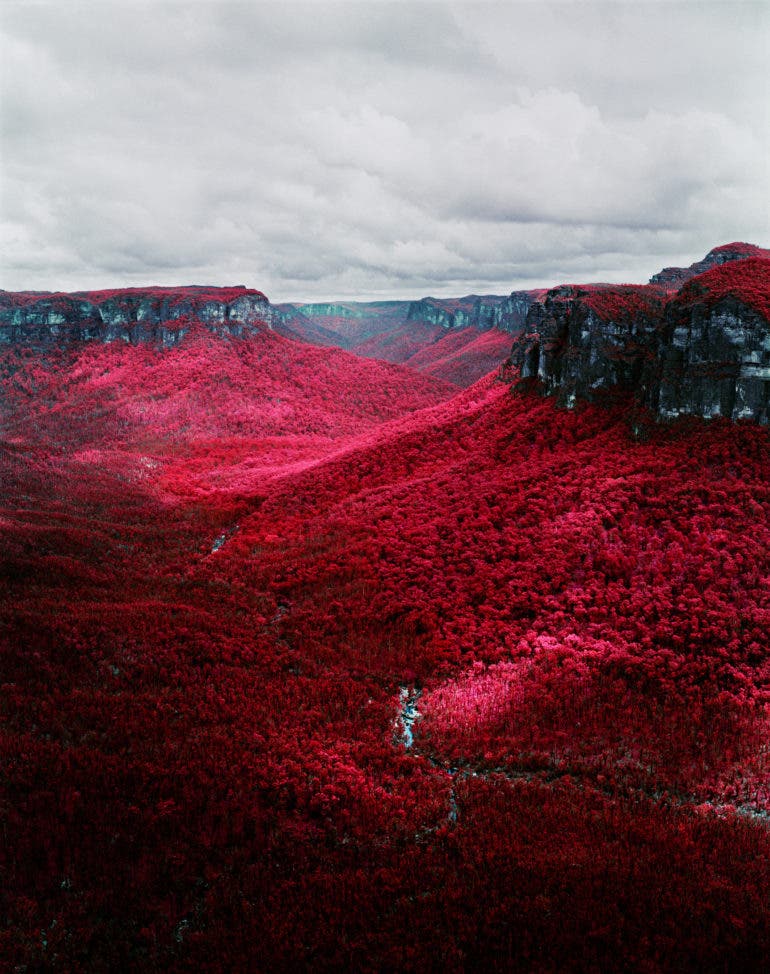
Walwyn tells us:
“For this series, I mostly used my Pentax 67II (primarily with the 75mm f2.8 lens but also lenses up to 400mm), and I also used a Mamiya 645 AFD II with the 80mm lens and my Fujifilm TX-2 (aka Hasselblad Xpan II) with the 45mm lens. When shooting Aerochrome, a yellow filter (or even other colors such as orange/red) is typically placed in front of the lens to limit the exposure of each layer of the film emulsions to its intended spectral region. The yellow filter reduces the blue sensitivity of each of the layers, which are all inherently sensitive to blue.
“In these images, when you see that magenta/red color, it is the result of the highly-infrared reflective leaves reflecting both infrared light (which appears as the color red) and green visible light (which appears as the color blue). It is the relative ratio of this reflectance (and the specific color filter used in front of the lens) that results in the leaves showing up as magenta. I’ve used a variety of filters in these images, but the one I use and recommend the most is a B+W 040 orange filter (equivalent to a #16 filter). I have also had nice results with the deeper yellow #15 filter.”
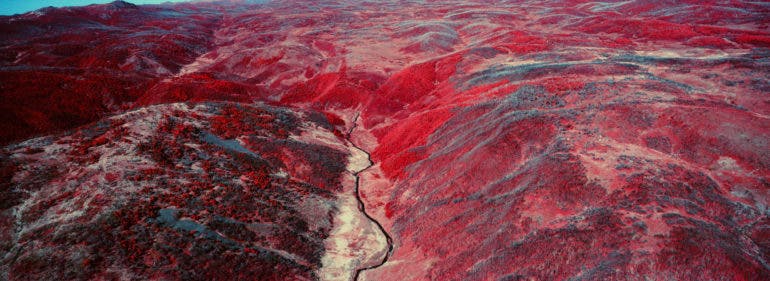
Phoblographer: Please tell us about how you got into photography in general and infrared photography in particular.
Rob Walwyn: I got into photography just over twelve years ago; my sister had just gotten a little Olympus waterproof point and shoot digital camera for her birthday, and I wanted to use it to shoot photos of my friends bodyboarding and surfing. Whilst I lost that camera pretty quickly in the ocean (sorry, Sarah!), that really kickstarted my photographic journey. I used to work in a camera store and shot with digital cameras for years (particularly in waterproof housings, taking photos of waves and surfers) but found something missing in both the images and the process.
Just before a surfing trip to Indonesia in 2012, I bought a Canon EOS3, which I could use with the same lenses as my Canon digital camera. I shot my first couple of rolls of film on that trip and was hooked on the results and the delayed gratification.
In terms of infrared photography, I had done some experiments with a digital camera and infrared filters, but for whatever reason had never really explored infrared film. In early 2020, I finally took the plunge and ordered some Aerochrome; once I saw those beautiful pink slides on a light table, I went very deep down the infrared film rabbit hole and spent outrageous amounts of money trying to buy up as much of the stock as I could.
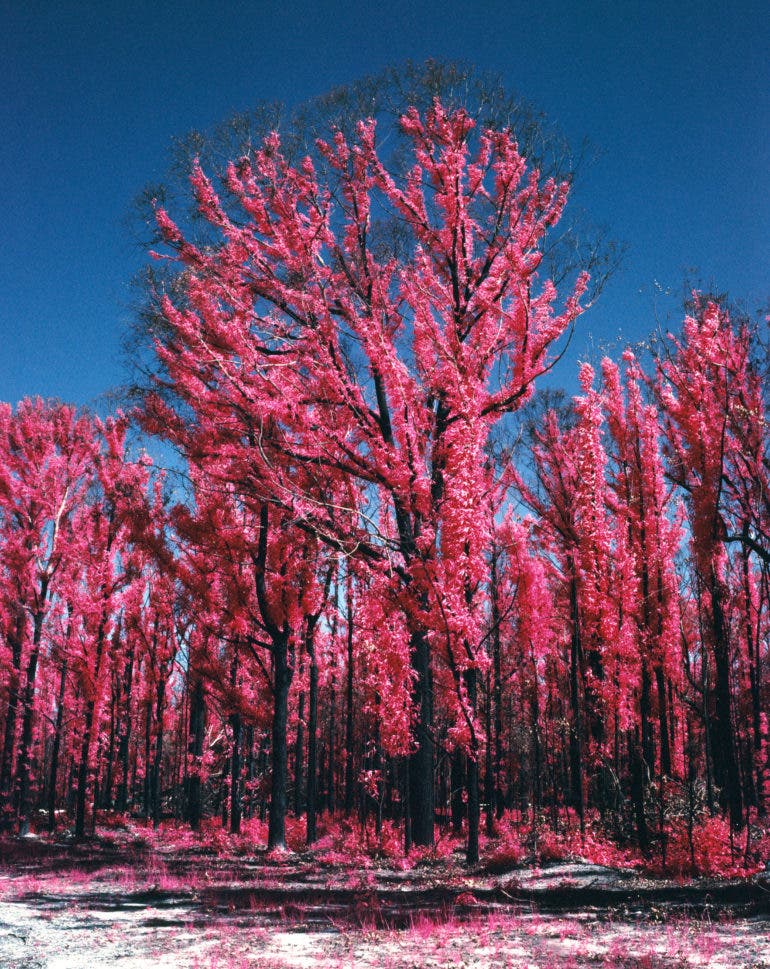
Phoblographer: These images are part of Karrikins, a project documenting the aftermath of the bushfire crisis in New South Wales. What was it like for you to witness this crisis, and how did your emotions during this time influence your approach to this series?
Rob Walwyn: It was a very strange time. Whilst I live in Sydney and was a step removed from the immediate impact of the bushfires, it certainly pervaded my thoughts and emotions over several months that summer. The smoke from the fires smothered Sydney for days at a time, and I have a vivid memory of being at work and not being able to see more than 50m visibility from the office block I worked in. I recall seeing some images in December of some people on the South Coast of NSW waiting in a tidal inlet to be rescued by boat, as flames flickered on the beach.
These bushfires, some of the most intense in living history, killed many people, burned nearly 19 million hectares of land, and killed or displaced over three billion animals. Those figures are staggering; yet as the world continues to heat up, such extreme weather events will only continue to occur, with increasing frequency and ferocity.
One of the biggest emotions I felt at this time was frustration with the lack of action being taken to address climate change. There was a significant amount of misinformation being spread by politicians and the media during the 2019-20 bushfires, including that there is no link between the unprecedented bushfires and man-made climate change. Whilst I didn’t necessarily know it at the time, this frustration and the results of my first roll of Aerochrome would lead me to undertake my first ever photographic project, and it has also driven me to become much more interested in the science behind bushfires and Indigenous land and fire management practices.

Phoblographer: How did you find enough Kodak Aerochrome for this project, and what drew you to this film?
Rob Walwyn: As far as I’m aware, there was only ever one source of medium format (120) rolls of Aerochrome: Dean Bennici, a US photographer now living in Germany. Dean discovered Aerochrome just around the time it was being discontinued and took up the arduous and difficult task of cutting down the bulk aerial rolls of film (which could be 5” or 9.5” wide) by hand in the dark and re-spooling them on 120 backing paper so that they could be used in medium format cameras.
Back in early February 2020, I purchased five rolls of Aerochrome from Dean for 40 euros a roll, which at the time I thought was ludicrously expensive. I was drawn to this film both from its fascinating history and, of course, the very alien but beautiful-looking results it can produce. I had always been pretty intrigued by infrared photography and the fact that the film was recording wavelengths of light our eyes can’t see.

Phoblographer: Did the history of this film influence your choice to use it?
Rob Walwyn: Years ago, I had seen Richard Mosse’s beautiful and haunting images of the conflict in the Congo, with lurid shades of pinks and reds where the rolling hills and dense jungle should have been verdant. At that stage, I learned about Kodak Aerochrome, but due to the price of the rolls I had seen on eBay, which were way out of my budget, I never looked further into it. It was only about a year ago that I must’ve seen some images on Instagram, and that really drove me to research it further.
I knew a little bit about the history of the film from what I had learned reading about Richard Mosse’s projects Infra and The Enclave, but I’d be lying if I said that the decision to shoot that first roll of Aerochrome on the bushfire regrowth was anything but an aesthetic choice. I was hoping that bright green new regrowth snaking up the trees would look beautiful on Aerochrome. It was really only after I got the first roll back and received some feedback on the images that I thought this could make for a really special project.
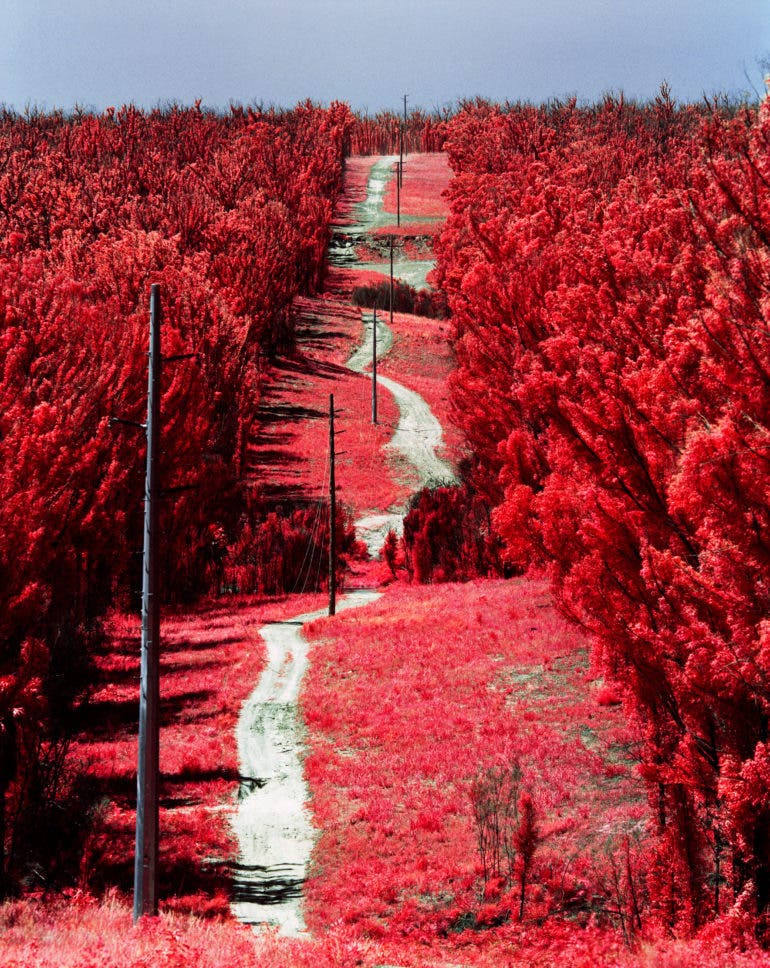
Phoblographer: What are the biggest technical challenges that come with shooting Aerochrome, and how have you overcome them?
Rob Walwyn: First and foremost, you need to be able to find some of the stuff; it has become extremely elusive and expensive since Dean’s supply ran out in March this year. Once you’ve got your mitts on some of this rare film, you then need to be aware of how sensitive infrared film is to heat. From what I understand, when Kodak used to ship their color infrared film, it would come in a cooler bag filled with dry ice.
Films should be frozen for any long-term storage, and this should limit the degradation and extend its useful life by years, noting all stock expired around 2010/11 already. The film should be taken out of the freezer ideally the night before you plan to shoot it and allowed to gradually warm up to room temperature over several hours before opening the sealed canister.
Another hurdle that needs to be overcome is how to expose this film properly. The recommended ISO for this film (with all kinds of caveats, like time of day/season, geographical location, height above sea level, etc.) is ISO 400, which already takes into consideration the use of a yellow #12 filter (i.e. assumes you will have the filter on your lens and will be measuring the light using a separate handheld meter, your phone, or even the Sunny 16 rule with the ISO set to 400 and not metering through the yellow filter). Using this ISO as a guide, you should get a roll full of decently exposed slides.
The general rule of thumb would then be to increase the exposure by a specific factor if you are using a deeper filter than a yellow #12 (e.g. increase exposure by an extra half to two-thirds of a stop if you are using an orange #16 filter, or up to one stop if using a red filter). One method I have used to good success is to set my Pentax 67II’s TTL meter to ISO 400, and meter through the filter (attached to the lens) using the camera’s spot meter mode on the brightest green leaves in a scene, which I set to 0 exposure (i.e. neutral grey).
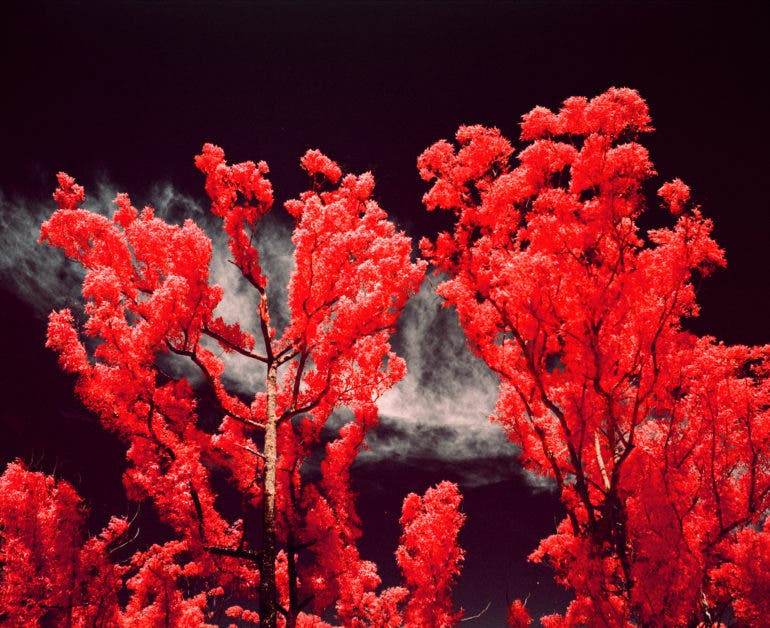

Phoblographer: This film works well with healthy vegetation, but you took a different route by using on these burned and blackened trees (albeit with pops of regrowth). How did you choose your locations?
Rob Walwyn: I was familiar with some of the places that were hit heavily by the fires, having spent a lot of time hiking in the Blue Mountains and holidaying and surfing down on the South Coast of NSW. I had seen some pictures of the fluffy green regrowth on social media and did a bit of research using location hashtags on Instagram to get a sense of where some good locations might be. I then went driving and on a few bushwalks in areas that looked promising, stopping whenever something caught my eye.

Phoblographer: You made some of these images from a helicopter. What was it like to bear witness to these landscapes from above, especially during this moment in their history?
Rob Walwyn: The helicopter ride was absolutely incredible; I’ve never had my jaw drop quite as much as seeing the beautiful Snowy Mountains of NSW from above. The area that we flew over wasn’t directly affected by these most recent 2019/20 fires (though considerable areas of the Kosciuszko National Park were), but it was devastated by significant bushfires in 2003/04.
Even seventeen years on, you could still see the scars left on the landscape and the bleached skeletal trees left behind. The heli ride left from Jindabyne and circled over the main range and Mt Kosciuszko and surrounds. It was incredibly beautiful, and despite being an hour-long, the flight time absolutely whizzed by. I shot three rolls of Aerochrome on that flight and was pretty stoked with some of the results, especially a couple of the more abstract shots and the image of the river.

Phoblographer: How much Aerochrome do you have left? Has its finite supply influenced the way you’ve approached this project?
Rob Walwyn: I have about 25 rolls of Aerochrome left in 120, a couple of boxes of 4×5 sheets, and a small handful of rolls in 35mm (mostly the other similar but different emulsion Kodak released in 35mm only, Kodak EIR). I was extremely fortunate to buy the film when I did. Once I got the results back from the first roll, I poured as much money as I could find into securing some additional rolls, as I knew how unique and rare it was.
I also got really lucky and managed to find a stash locally in Australia from a deceased photographer’s estate, including two bulk rolls (which had been frozen their entire life!) of an older emulsion of Aerochrome 2443 (which needs slightly more complex development than just standard C41/E6), in a 5” x 600ft long bulk roll, as well as a 70mm x 100ft roll. I purchased the bulk 5” wide roll with my friend Steve Frizza, who is the owner of Rewind Photo Lab here in Sydney, where I get all my Aerochrome developed. He is helping cut it down into 4×5” sheets in the dark.
The limited supply has definitely influenced my approach to this project. It’s extremely painful to waste a frame, given that on a 120 roll shooting 6×7, each image may cost anywhere from $10-15 (likely even more now) including processing. It really makes me consider each shot more and whether it is something that is worth burning one of the finite number of shots I have left. I’ve still got enough of the stock left to continue this project and do some slightly more experimental shots, but I also want to keep enough in reserve for future holidays and projects.

Phoblographer: You have a lifelong passion for the natural world, and it must have been very painful to see this kind of devastation up-close. Do you see this body of work as mournful or hopeful? Are they the result of grief, or do they represent a promise for a better future?
Rob Walwyn: To me, it’s certainly a bit of both. The images mourn the loss of the innumerable hectares of diverse landscape that were scorched, the billions of animals who lost their lives, and the humans who tragically lost their lives and homes, but they also evoke a sense of beauty and the hope that it is possible to restore things to the way they were before we humans came along. We can start to make changes by rapidly transitioning to renewable energy and more sustainable ways of producing and consuming food and goods. Just as the trees in these images can regenerate following a fire, so too could the natural world if we gave it a chance.

All photos by Rob Walwyn. Used with permission. For more from Walwyn, visit his website. Follow along on Instagram at robwalwyn. Karrikins will be on view at Barometer Gallery in Paddington, Sydney, from November 10th to 14th, 2021, as part of the Head On Photo Festival.